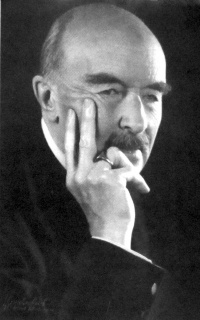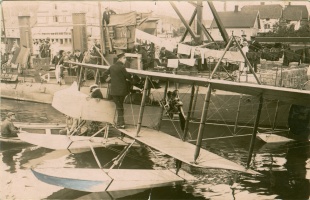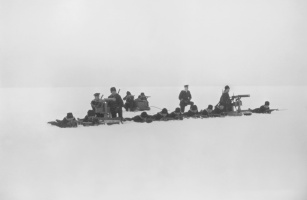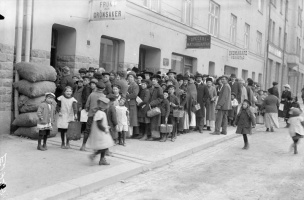Benevolent Neutrality↑
In 1914, the image of Sweden as fiercely anti-Russian and strongly pro-German was firmly rooted in international opinion. Nonetheless, the Swedish government issued a declaration of neutrality on 2 August, which was repeated on 3 August and again on 8 August, following Britain’s entry into the war, when a joint Swedish-Norwegian declaration of neutrality was issued. Neutrality was the only policy that the majority of Swedes would support. It was also the only policy that seemed compatible with the country’s economic interests. That the foreign minister Knut Agathon Wallenberg (1853-1938) belonged to the leading dynasty of bankers and industrialists in Sweden indicated to the surrounding world that business interests would weigh heavily in foreign policy decisions and prevent Sweden taking an active stance with any of the belligerents.[1]
Still, Swedish neutrality was not to be entirely unbiased. Wallenberg assured the German government that Sweden’s neutrality would be “benevolent” in relation to Germany. Wallenberg’s promise was probably motivated by fear of German reprisal. In the spring of 1913, Wilhelm II, German Emperor (1859-1941) had told Gustav V, King of Sweden (1858-1950) that on the outbreak of a major European war, he would immediately deliver an ultimatum to Stockholm demanding that Sweden join Germany within twenty-four hours.[2] The benevolence of the Swedish government included the transmission of secret cables to German diplomatic missions overseas and Swedish diplomats trying to convince the Italian and Rumanian governments that they should not enter the war on the side of Germany’s enemies in 1915-1916. Sweden also switched off lighthouses, removed coastal marks, and, in the summer of 1916, even mined the Swedish side of the Baltic approaches, so that British submarines could not enter.[3] Even if these measures contributed little to the German war effort, they created tensions in Sweden’s relations with the Entente.
Russia, Germany and Britain↑
Somewhat ironically, the great power with which Sweden maintained the most harmonic relations during the First World War was Russia, which had been perceived as the main threat to national security before 1914.[4] The experienced Swedish diplomatic staff in Saint Petersburg supplied Stockholm with fairly realistic assessments of Russian intentions. The transit trade between the western powers and Russia across Scandinavia flourished, as did Swedish exports to Russia. The levels of military contingency along Sweden’s border with the Grand Duchy of Finland remained at low levels. The Bolshevik seizure of power in November 1917, however, constituted a major setback and led to massive confiscations of Swedish property (the estimated value of which was equivalent to some 6 percent of Sweden’s GNP in 1917). To save as much as possible of the lost fortunes, Sweden maintained a diplomatic presence in Russia until November 1918, longer than any other western power did.[5]
Due to the British blockade, Sweden’s southern great-power neighbour Germany quickly became a major market for Swedish exports. In the autumn of 1914, Swedish meat exports saw a nine-fold increase, and large numbers of Swedish horses were sold to the German army. In February 1915, Germany secretly promised not to intervene against Swedish timber exports to Britain, if Sweden guaranteed that the horse trade would not cease. Another priced commodity from Sweden was iron ore. Out of Sweden’s total export in 1917 – 5.8 million tons – 4.9 million tons went to Germany. There was a half-hearted attempt by Berlin to draw Sweden into the war in November 1915, when the Swedish government – as a reward for joining the Central Powers – was discreetly offered the strategically important Åland Islands, close to Stockholm. This proposal was immediately turned down. In November 1917, after the Bolsheviks had seized power in Russia, Germany again offered Sweden Åland, and the offer was again rejected. In February 1918, Sweden also turned down a German plea to intervene in the Finnish Civil War but had no objections to German intervention. After the Red uprising had been crushed, Sweden also signed a secret treaty with Germany, agreeing to demolish the Russian fortifications on the islands together with Germany and Finland, without involving any third parties.[6]
Britain was the great power with which Sweden had the tensest relationship during the war. Britain expected that Sweden and other neutrals would guarantee that they would not re-export any imports allowed through the British blockade barrier to Germany. This the Swedish government refused to do, arguing that it would be un-neutral to assist one belligerent in its economic warfare against another belligerent. At first, the British abstained from putting pressure on Sweden out of consideration for Russia, which depended heavily on transit-trade through Swedish territory. When negotiations during 1915-1916 for an Anglo-Swedish war trade treaty led nowhere, Britain started to restrict Swedish overseas imports. Sweden fought back by obstructing British mail deliveries to Russia, but Sweden’s supply situation soon became problematic. In 1916, sugar was rationed.[7]
The War Activists↑
Public opinion in Sweden distinguished itself among European neutral countries through strong pro-German sympathies. There were close cultural, economic, and dynastic ties between Sweden and Germany, and the German news agency Wolff Telegraph Bureau was the main source of information for the Swedish press.[8] A prominent spokesman for the German view in Sweden was the internationally renowned explorer of Central Asia, Sven Hedin (1865-1952), who had warned tirelessly of Russia’s expansionist intentions before the war, during the fierce domestic political struggle over defence in 1912-1914. In 1914-1915, Hedin eloquently argued for Sweden joining the Central Powers in voluminous war reports, originating from his trips to the German armies along the Western and Eastern Fronts.[9] Another influential German sympathizer was geography professor and conservative parliamentarian Rudolf Kjellén (1864-1922), credited as the inventor of the term “geopolitics”, who depicted the ongoing war as an ideological struggle between the Anglo-French liberal, individualistic ideals of “1789” and the modern, nationalist-conservative, collectivist ideals of “1914”, embodied by Wilhelmine Germany.[10]
Conservatives dominated the pro-German camp, but it also contained social democrats, as German social democracy had been a model for the Swedish labour movement since the 1880s. When four anonymous authors, Rudolf Kjellén among them, published a pamphlet urging Sweden to “courageously side with Germany” in the summer of 1915, two of the authors were influential members of the Social Democratic Party – Otto Järte (1881-1961) and Yngve Larsson (1881-1977). When their identities were disclosed, they were immediately expelled from their party, as was Professor Gustaf Steffen (1864-1929), a social democratic member of parliament who had expressed similar views. In 1916, Steffen, who stayed on in parliament as an independent, made an interpellation to the foreign minister concerning the fortifications that Russia had erected on the demilitarized Åland Islands since 1915. The Entente Powers immediately reassured the Swedish government that the Russian fortifications were to be dismantled after the war. After this, Steffen’s interpellation could no longer mobilize Swedish public opinion for the activist cause, as he had intended. With the weekly journal Svensk Lösen (Swedish Countersign) as their main organ, the activists continued their agitation until the end of the war, but their political importance quickly diminished.[11]
Nordic Cooperation↑
In 1912, when the First Balkan War threatened to escalate into a major European conflict, the three Scandinavian kingdoms had harmonized their neutrality regulations. All three governments were likewise determined to remain neutral when war broke out in 1914 and hoped to facilitate this through cooperation. In reality, their respective security interests and relations to the belligerent great powers differed greatly. For this reason, it became even more important for them to stage public demonstrations of Scandinavian unity and determination, as with the meetings between the three Scandinavian monarchs in the city of Malmö on the south coast of Sweden in December 1914 and the follow-up meeting in the Norwegian capital Kristiania (present-day Oslo) three years later.[12]
The only field in which the three Scandinavian governments cooperated more closely during the war was censorship. An agreement signed in Copenhagen in November 1916 between Sweden, Norway, and Denmark stated that the parties would suppress the circulation of unauthorized information which threatened to undermine the neutrality of any Scandinavian country or contained sensitive information about its military measures or ship movements in its territorial waters. In 1917-1918, when the fear of revolution was rising, this cooperation was extended to include news telegrams originating from belligerent countries which contained information about domestic conditions on the opposing side. There was also a Scandinavian agreement to increase control and supervision of foreign travellers.[13]
Diplomatic Concessions and Violations↑
Sweden’s government under Prime Minister Hjalmar Hammarskjöld (1860-1953) had weak parliamentary backing. It had been appointed by the king as a temporary caretaker government in the spring of 1914 but was forced to remain in office due to the outbreak of war. Hammarskjöld was a distinguished law professor from Uppsala University and a former member of the Permanent Court of Arbitration in The Hague. He thus regarded himself as sufficiently competent in the field of international relations not to have to ask parliament for advice. This merely increased his unpopularity.
Hammarskjöld’s formalistic interpretation of international neutrality regulations contributed much to Sweden’s conflict with Britain over trade. In November 1914, when the three Scandinavian countries protested to Britain, France, and Germany over disturbances in their trade caused by the war, the Swedish prime minister told the great powers that in the future, they would be grateful to the Scandinavians who so selflessly had protected the principles of international law and “the common heritage of civilized states”. Clearly, Swedish career diplomats found this exacting tone embarrassing. In this sense, Hammarskjöld’s foreign policy was as a precursor of the so-called “active Swedish foreign policy” of the 1970s and 1980s, which contained moral criticism of the superpowers and declarations of solidarity with the Third World.
The Neutral Victor?↑
Hammarskjöld’s insensitive handling of the conflict with Britain created tension within his government, especially between him and his more pragmatic foreign minister Wallenberg, who closely identified with industrial and business interests and worried about labour unrest. In early March 1917, when parliament had turned down a government plea to give more money to the military contingency forces, the Hammarskjöld government finally resigned. Hammarskjöld’s successor as prime minister, Carl Swartz (1858-1926), belonged to the moderate conservatives in parliament and could not pretend to be an unpartisan official. At this point, the United States (U.S.) was about to join the war and small neutrals like Sweden could no longer expect to have the backing from a great power in their quarrels with Britain. After a harsh winter, Sweden’s food situation was becoming desperate. Imports had decreased to less than 50 percent of pre-war levels and food prices had gone up some 40 percent. In the course of 1917, rations on bread, flour, meat, and milk were introduced. The nation was facing starvation and, in the wake of the revolution in Russia, social and political unrest grew. It was urgent to reach a settlement with the Entente. An initial treaty was signed in May 1917, according to which Sweden would guarantee safe passage for allied tonnage trapped in the Baltic Sea since the outbreak of war (altogether more than 130,000 tons). In exchange, Sweden would be allowed to import cereals and other vital products. Through some minor concessions, Sweden managed to get Germany to accept this treaty without reprisals.
In September 1917, U.S. foreign minister Robert Lansing (1864-1928) released the so-called “Luxburg telegrams”, a few of the 1,650 German diplomatic cables transmitted by the Swedish foreign ministry since 1914. Even if Lansing’s objective was to embarrass Germany, the reputation of the Swedish government also suffered. When the news reached Sweden, the country was in the midst of parliamentary elections, and it is likely that the Luxburg telegrams contributed to the outcome: the conservative Swartz government had to resign and was succeeded in October by a liberal-social democratic government under Nils Edén (1871-1945) and Hjalmar Branting (1860-1925). In November 1918, this government proposed constitutional and electoral reforms, which transformed Sweden into a modern democracy.
The former foreign minister Knut Wallenberg and his brother Marcus Wallenberg (1864-1943) played a crucial role in convincing the king to appoint Edén and Branting. The Wallenberg brothers were interested in a trade agreement and knew that this would be easier to achieve under liberals and social democrats, with their strong pro-Entente leanings, than under the conservatives. Above all, the Wallenbergs trusted the designated foreign minister in the new government, Johannes Hellner (1866-1947), who was a moderate liberal with some experience from trade negotiations with the allies, as well as a board member of their own bank.
When Sweden renewed the London talks in December 1917, the Bolsheviks had seized power in Russia and were about to exit from the war. This meant that the transit route to Russia – which so far had been Sweden’s major asset vis-a-vis the western powers – no longer carried much weight. The remaining asset was the Swedish merchant fleet, as the allies were pressed by German submarines and desperate for additional tonnage. In the treaty, which was finally concluded in May 1918, Sweden accepted British demands for guarantees against re-exportation, allowed the allies to hire some 400,000 tons of Swedish shipping, and promised to reduce iron ore exports to Germany to 3.5 million tons per year (a 30 percent reduction). Again, Sweden had secured Germany’s acceptance of the treaty in advance. By managing to transform its neutrality policy from a pro-German to a more impartial course focused on protecting its own interests and maintaining trade with both sides, Sweden, in the words of historian Steven Koblik, became “a neutral victor”. During the final phase of the negotiations, the Swedes also benefitted much from the divisions between the British and the Americans.[14]
Sweden’s traumatic experience of domestic strife in a time of international crisis led to constitutional reform after the war, which institutionalized parliament’s influence on foreign policy (the creation of the Utrikesnämnden, a permanent committee on foreign relations, in 1919). Moreover, shortly after the outbreak of the Second World War in 1939, a broad four-party coalition government was formed, which, in spite of much internal tension, kept up an unwavering front of national unity throughout the conflict.[15] The rigorous demands for public consensus on Swedish non-alignment would live on throughout the Cold War as well. Thus, it could be argued that Hammarskjöld’s government cast its shadow over Swedish politics for the rest of the 20th century.
Gunnar Åselius, Swedish Defence University
Section Editor: Lina Sturfelt
Notes
- ↑ Gihl, Torsten: Den svenska utrikespolitikens historia 1914-1919 [A History of Swedish Foreign Policy, 1914-1919], Stockholm 1951, remains the standard work on Swedish foreign policy during the war.
- ↑ Carlgren, Wilhelm M.: Neutralität oder Allianz. Deutschlands Beziehungen zu Schweden in den Anfangsjahren des Ersten Weltkrieges, Stockholm 1962, pp. 18-21, 40-53.
- ↑ The central work on the Öresund question is Grohmann, Andreas: Die deutsch-schwedische Auseinandersetzung um die Fahrstrassen des Öresunds im Ersten Weltkrieg, Boppard 1974.
- ↑ On Russia in Swedish foreign policy and strategic thinking before 1914 see Åselius, Gunnar: The ‘Russian Menace to Sweden’. The Belief System of a Small Security Élite in the Age of Imperialism, Stockholm 1994.
- ↑ Åselius, Gunnar: Sveriges säkerhetspolitiska hotbild och 1917 [The Swedish Threat Perception and 1917], in: Knutson, Ulrika et al.: Revolution! Svenska erfarenheter från Ryssland [Revolution! The Swedish Experience from Russia], Stockholm 2019, pp. 105-144; on Swedish losses in revolutionary Russia, see Kragh, Martin: Sveriges näringsliv i den ryska revolutionen [Swedish Enterprise in the Russian Revolution], in: Knutson, Revolution! 2019, pp. 25-43.
- ↑ Åland, see Rystad, Göran: Die deutsche Monroedoktrin der Ostsee. Die Alandsfrage und die Entstehung des deutsch-schwedische Geheimabkommens vom Mai 1918, in: Rystad, Göran / Tägil, Sven (eds.): Probleme deutscher Zeitgeschichte, Stockholm 1971, pp. 1-75.
- ↑ There is an excellent overview of Scandinavian relations with the Great Powers during the First World War in Salmon, Patrick: Scandinavia and the Great Powers, 1890-1940, Cambridge 1997, pp. 118-168; see also Strøm, Knut Ola Naastad: Between the Devil and the Deep Blue Sea. Trade Negotiations between the Western Allies and the Scandinavian Neutrals 1914-1919, Gothenburg 2019.
- ↑ Ingmar, Gunilla: Monopol på nyheter. Ekonomiska och politiska aspekter på svenska och internationella nyhetsbyråers verksamhet 1870–1919 [Monopoly on News. Economic and Political Aspects of the Activity of International News Agencies 1870–1919], Stockholm 1973; Torbacke, Jarl: The German Infiltration of the Swedish Press during the Early Stages of the First World War, in: Engström, Johan / Ericson, Lars (eds.): Mellan björnen och örnen. Sverige och Östersjöområdet 1914-1918 [Between the Bear and the Eagle. Sweden and the Baltic Sea Region 1914-1918], Visby 1994; the First World War in Swedish public opinion has been treated most recently by Sturfelt, Lina: Eldens återsken. Första världskriget i svensk föreställningsvärld [Reflections of Fire. Images of the First World War in Sweden], Lund 2008.
- ↑ Hedin, Sven: Från fronten i väster [From the Front in the West], Stockholm 1914 and Kriget mot Ryssland [The War against Russia], Stockholm 1915. These works also appeared in German editions.
- ↑ Kjellén, Rudolf: Die Ideen von 1914. Eine Weltgeschichtliche Perspektive, Leipzig 1915. https://archive.org/details/dieideenvoneine00kochgoog/page/n6 (Retrieved 6 June 2019).
- ↑ The so-called “activist book” was entitled Sveriges utrikespolitik i världskrigets belysning [Sweden’s Foreign Policy in the Light of the World War], Stockholm 1915; on the activists see Kihlberg, Mats: Aktivismens huvudorgan. Svensk Lösen [The main organ of activism. Svensk Lösen], in: Kihlberg, Mats / Söderlind, Donald (eds.): Två studier i svensk konservatism, 1916-1922 [Two Studies in Swedish Conservatism, 1916-1922], Uppsala 1961; Schuberth, Inger: Schweden und das Deutsche Reich im Ersten Weltkrieg. Die Aktivistenbewegung 1914-1918, Bonn 1981.
- ↑ An overview of the neutrality policies of the Scandinavian countries can be found in Hobson, Rolf / Kristiansen, Tom / Sørensen, Nils Arne / Åselius, Gunnar: Introduction. Scandinavia in the First World War, in Ahlund, Claes (ed.): Scandinavia in the First World War. Studies in the War Experience of the Northern Neutrals, Lund 2012, pp. 105-121.
- ↑ Kilander, Svenbjörn: Censur och propaganda. Svensk informationspolitik under 1900-talets första decennier [Censorship and Propaganda. Swedish Information Policy during the First Decades of the Twentieth Century], Uppsala 1981, pp. 95-100, 116-120.
- ↑ The central work on this phase of the war is Koblik, Steven: Sweden. The Neutral Victor. Sweden and the Western Powers 1917-1918. A Study of Anglo-American-Swedish Relations, Lund 1972.
- ↑ Carlgren, W. M.: Svensk neutralitet 1914-1918 och 1939-1945 [Swedish neutrality 1914-1918 and 1939-1945], in: Historisk tidskrift (1979), pp. 377-397.
Selected Bibliography
- Åselius, Gunnar: The 'Russian menace' to Sweden. The belief system of a small power security elite in the age of imperialism, Stockholm 1994: Almqvist and Wiksell International.
- Åselius, Gunnar: Storbritannien, Tyskland och den svenska neutraliteten 1880-1914. En omvärdering (Britain, Germany and Swedish neutrality, 1880-1914. A re-evaluation), in: Historisk tidskrift 114, 1994, pp. 228-266.
- Åselius, Gunnar: Sveriges säkerhetspolitiska hotbild och 1917 (The Swedish threat perception and 1917), in: Knutson, Ulrika / Kragh, Martin; Jangfeldt, Bengt et al. (eds.): Revolution! Svenska erfarenheter från Ryssland (Revolution! The Swedish experience from Russia), Stockholm 2019: Förlaget Näringslivshistoria, pp. 105-144.
- Åselius, Gunnar: Sverige och den ryska Östersjöflottan (Sweden and the Russian Baltic Fleet), in: Arnshav, Mirja / Linderoth, Andreas (eds.): Sverige och första världskriget. Maritima perspektiv (Sweden and the First World War. Maritime perspectives), Lund 2017: Historiska Media, pp. 29-42.
- Carlgreen, Wilhelm M.: Ministaren Hammarskjold. Tillkomst, sondring, fall. Studier i Svensk politik, 1914-1917 (The Hammarskjöld government. Origins, dissolution, fall. Studies in Swedish politics 1914–1917), Stockholm 1967: Almquist & Wiksell.
- Carlgren, Wilhelm M.: Svensk neutralitet 1914-1918 och 1939-1945 (Swedish neutrality 1914-1918 and 1939-1945), in: Historisk tidskrift 99, 1979, pp. 377-397.
- Carlgren, Wilhelm M.: Neutralität oder Allianz. Deutschlands Beziehungen zu Schweden in den Anfangsjahren des ersten Weltkrieges, Stockholm; Göteborg; Uppsala 1962: Almqvist och Wiksell.
- Gihl, Torsten / Ahnlund, Nils (eds.): Den svenska utrikespolitikens historia, 1914-1919 (The history of Swedish foreign policy, 1914-1919), volume 4, Stockholm 1951: Norstedt.
- Grohmann, Justus-Andreas: Die deutsch-schwedische Auseinandersetzung um die Fahrstrassen des Öresunds im Ersten Weltkrieg, Boppard am Rhein 1974: H. Boldt.
- Hobson, Rolf / Kristiansen, Tom / Sørensen, Nils Arne et al.: Introduction. Scandinavia in the First World War, in: Ahlund, Claes (ed.): Scandinavia in the First World War. Studies in the war experience of the northern neutrals, Lund 2012: Nordic Academic Press, pp. 9-56.
- Ingmar, Gunilla: Monopol på nyheter. Ekonomiska och politiska aspekter på svenska och internationella nyhetsbyråers verksamhet 1870-1919 (Monopoly on news. Economic and political aspects of the activity of international news agencies 1870-1919), thesis, Stockholm 1973: Uppsala universitet.
- Kihlberg, Mats: Aktivismens huvudorgan Svensk Lösen (The main organ of activism – Svensk Lösen), in: Kihlberg, Mats / Söderlind, Donald (eds.): Två studier i svensk konservatism 1916-1922 (Two studies in Swedish conservatism, 1916-1922), Stockholm 1961: Almqvist & Wiksell, pp. 105-121.
- Kilander, Svenbjörn: Censur och propaganda. Svensk informationspolitik under 1900-talets första decennier (Censorship and propaganda. Swedish information policy during the first decades of the twentieth century), thesis, Uppsala 1981: Uppsala universitet.
- Koblik, Steven: Sweden. The neutral victor. Sweden and the Western powers 1917-1918. A study of Anglo-American-Swedish relations, Stockholm 1972: Läromedelsförlagen.
- Kragh, Martin: Sveriges näringsliv i den ryska revolutionen (Swedish enterprise in the Russian Revolution), in: Knutson, Ulrika / Kragh, Martin; Jangfeldt, Bengt et al. (eds.): Revolution! Svenska erfarenheter från Ryssland (Revolution! The Swedish experience from Russia), Stockholm 2019: Förlaget Näringslivshistoria, pp. 25-43.
- Rystad, Göran: Die deutsche Monroedoktrin der Ostsee. Die Alandsfrage und die Entstehung des deutsch-schwedischen Geheimabkommens vom Mai 1918, in: Rystad, Göran / Tägil, Sven (eds.): Probleme deutscher Zeitgeschichte, Stockholm 1970: Läromedelsförlaget, pp. 1-75.
- Salmon, Patrick: Scandinavia and the great powers, 1890-1940, New York 1997: Cambridge University Press.
- Schuberth, Inger: Schweden und das Deutsche Reich im Ersten Weltkrieg. Die Aktivistenbewegung 1914-1918, Bonn 1981: Röhrscheid.
- Strøm, Knut Ola: Between the devil and the deep blue sea. Trade negotiations between the western allies and the Scandinavian neutrals, 1914-1919, thesis, Gothenburg 2019: University of Gothenburg.
- Sturfelt, Lina: Eldens återsken. Första världskriget i svensk föreställningsvärld (Reflections of fire. The First World War in Swedish imagination), Lund 2008: Sekel Förlag.
- Torbacke, Jarl: The German infiltration of the Swedish press during the early stages of the First World War, in: Engström, Johan / Ericson, Lars (eds.): Mellan björnen och örnen. Sverige och Östersjöområdet under det första världskriget, 1914-1918. Föredrag hållna vid symposium i Visby, 4-7 augusti 1993 (Between the eagle and the bear. Sweden and the Baltic region during the First World War, 1914-1918), Visby 1994: Gotlands Fornsal, pp. 73-80.














